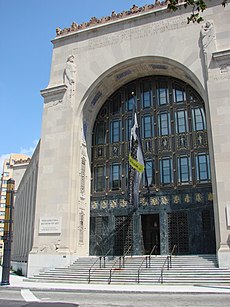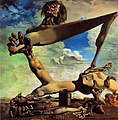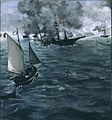Philadelphia Museum of Art
 | |
 | |
| Established | 1876 |
|---|---|
| Location | Benjamin Franklin Parkway, Philadelphia |
| Director | TBD |
| Website | www.philamuseum.org |
The Philadelphia Museum of Art, located at the west end of the Benjamin Franklin Parkway in Philadelphia's Fairmount Park, was established in 1876 in conjunction with the Centennial Exposition of the same year and is now among the largest art museums in the United States. Originally the Pennsylvania Museum and School of Industrial Art, its founding was inspired by the South Kensington Museum (now the Victoria and Albert Museum) in London, which grew out of the Great Exhibition of 1851. It is known locally and colloquially as "The Art Museum." The museum opened its doors to the public on May 10, 1877, originally housed in Memorial Hall. While the location was adequate, it was isolated from the bulk of the city.[1]
Construction of the current building began in 1919 when Mayor Thomas B. Smith laid the cornerstone in a Masonic ceremony on the former reservoir land of the decommissioned Fairmount Water Works covering ten acres of ground.[2] The first section was completed in the spring of 1928. The quasi-Greek Revival design was produced by Horace Trumbauer and the firm of Zantzinger, Borie and Medary.[1] The façade of the building is of Minnesota dolomite. The pediment facing the parkway is adorned with sculptures by C. Paul Jennewein depicting Greek gods and goddesses. There is also a collection of griffins, which were adopted as the symbol of the museum in the 1970s.[1]
For the better part of a century the McIlhenny family held an important relationship with the museum. Henry P. McIlhenny was involved for almost half a century, first as curator from 1939 to 1964, then as chairman of the board in 1976 until his death in 1986, when he left the bulk of his estate to the museum.
The institution describes itself as "one of the largest museums in the United States"[3], and its collections include more than 225,000 objects,[4] Though the Museum houses over 200 galleries spanning 2,000 years[5], it does not have any galleries devoted to Egyptian, Roman, or Pre-Columbian art. This is because a partnership between the museum and the University of Pennsylvania had been enacted early in the museum's history. The University loaned the museum its collection of Chinese porcelain, and the Museum loaned a majority of its Roman, Pre-Columbian, and Egyptian pieces to the University. However, the museum keeps a few important pieces for special exhibitions.
Fidelity Mutual Life Insurance Company Building | |
| Location | Fairmount and Pennsylvania Aves., Philadelphia, Pennsylvania |
|---|---|
| Built | 1926 |
| Architect | Zantzinger & Borie; Lawrie,Lee |
| Architectural style | No Style Listed |
| NRHP reference No. | 73001662 [6] |
| Added to NRHP | July 02, 1973 |
Collections

Each year the Museum puts on 15 to 20 special exhibitions and is visited by 800,000 people. Some of the larger and most famous special exhibitions, which have attracted hundreds of thousands of people from every state and around the world, include shows featuring Paul Cézanne (in 1996, attracting 548,000) and Salvador Dalí (in 2005, attracting 370,000).
Widely regarded as a world-class art institution, the Philadelphia Museum of Art includes not only its iconic Main Building, but also the Rodin Museum (also on the Benjamin Franklin Parkway) and several other historic sites. The recently acquired Ruth and Raymond G. Perelman Building (across the street from the Main Building) opened in 2007 and houses for public display a few of the Museum's more popular collections. It includes five new exhibition spaces, a sky lit galleria, and a café overlooking a landscaped terrace. [5]
In the 18th century, Philadelphia was one of the most important cities in North America and was a center of style and culture.[7] The museum is particularly known for its important collections of Pennsylvania German art, 18th- and 19th-century furniture and silver by early Philadelphia and Pennsylvania craftsmen, and works by prominent Philadelphia artist Thomas Eakins. The museum houses the most important Eakins collection in the world.
Overview of the collections
As one of the nation's great artistic and historic resources, the Museum houses more than 225,000 objects highlighting the creative achievements of the Western world since the first century A.D. and those of Asia since the third millennium B.C..[4]
Highlights of the Asian collections include paintings and sculpture from China, Japan, and India; furniture and decorative arts, including major collections of Chinese, Japanese, and Korean ceramics; a large and distinguished group of Persian and Turkish carpets; and rare and authentic architectural assemblages such as a Japanese teahouse, a Chinese palace hall, and a sixteenth-century Indian temple hall.[4]
The European collections, dating from the medieval era to the present, encompass Italian and Flemish early-Renaissance masterworks; strong representations of later European paintings, including French Impressionism and Post-Impressionism; sculpture, with a special concentration in the works of Auguste Rodin; decorative arts; tapestries; furniture; the second largest collection of arms and armor in the United States; and period rooms and architectural settings ranging from the façade of a medieval church in Burgundy to a superbly decorated English drawing room by Robert Adam.[4]
The museum's American collections, surveying three centuries of painting, sculpture, and decorative arts, are among the finest in the United States, with outstanding strengths in 18th and 19th-century Philadelphia furniture and silver, rural Pennsylvania furniture and ceramics, and the paintings of Thomas Eakins.[4]
Modern artwork include extraordinary concentrations of work by such artists as Pablo Picasso, Marcel Duchamp, and Constantin Brancusi, as well as American modernists, making the museum one of the best in the world in which to see modern art. The expanding collection of contemporary art includes major works by Cy Twombly, Jasper Johns, and Sol LeWitt, among many others.[4]
In addition to these collections, the museum houses encyclopedic holdings of costume and textiles as well as prints, drawings, and photographs that are displayed in rotation for reasons of preservation.[4]
The Carl Otto Kretzschmar von Kienbusch Collection
The museum also houses the comprehensive armor collection of Carl Otto Kretzschmar von Kienbusch. The Von Kienbusch collection was bequeathed by the celebrated collector to the Philadelphia Museum of Art in 1976, the Bicentennial Anniversary of the American Revolution. The Von Kienbusch holdings are comprehensive, and include European arms and armor spanning several centuries.[8]
A few years ago, the Philadelphia Museum of Art reached an agreement with German authorities for the return of five pieces of armor stolen from Dresden during World War II. In 1953, collector von Kienbusch purchased the armor unsuspectingly. It was donated to the Art Museum in 1976. Kienbusch published catalogs of his collection, which eventually led Dresden authorities to bring the matter up with the Art Museum.[9][10]
Notable holdings
-
Toulouse-Lautrec, The Dance at Moulin Rouge, 1889-90
-
Pierre-Auguste Renoir, The Large Bathers, 1887
-
Claude Monet, Japanese Bridge and Water Lilies, c.1899
-
Claude Monet, Poplars (Autumn), 1891
-
Georges-Pierre Seurat, Gray weather, Grande Jatte, 1888
Gallery expansion
Due to overwhelming popularity and overflowing collections, it was announced in October 2006, that Frank Gehry will be designing an expansion to the museum. The 80,000-square-foot (7,000 m2) gallery will be built entirely underground beneath the Rocky Steps and will not alter any of the museum's existing Greek revival facade. Though the date for construction to begin has not been announced, the construction is projected to last a decade and cost $500 million. It will increase the museum's available display space by sixty percent and house mostly contemporary sculpture, Asian art, and special exhibitions.[11]

The outdoors of the museum is currently getting a "facelift."[12] While the museum itself is expanding across the street, some 200,000 books and periodicals and 1.6 million other documents are moving from the Main Building to the art deco former headquarters of the Fidelity Mutual Life Insurance Company across the street at Fairmount and Pennsylvania avenues[13]. It has been renamed the Perelman Building.[14]
The Fidelity Mutual Life Insurance Company Building was constructed in 1927 by Philadelphia-based architects Zantzinger, Borie and Medary and was adorned by sculptors Lee Lawrie and Samuel Yellin. In 1982 it was restored and later acquired by the Reliance Standard Life Insurance Company.[15]
Relationship to Philadelphia
Besides its architecture and collections, the Philadelphia Museum of Art is well known for the role it played in a famous scene in the film Rocky, and also in four of its sequels, II, III, V and Rocky Balboa. Visitors to the museum can frequently be seen mimicking Rocky's famous run up the front steps, now known locally as the Rocky Steps.[16]
A bronze statue of Rocky was briefly placed at the top of the steps for the filming of Rocky III. The statue was later moved to the Wachovia Spectrum due to a furious debate over the meaning of "art". The statue was returned to the steps for the filming of Rocky V, and also appears there in the movies Philadelphia and Mannequin, but has since been removed. The statue was replaced with a simple set of footprints reading "Rocky." The statue was returned to the foot of the steps on September 8, 2006.[17]

Because of its location at the end of the Ben Franklin Parkway, the museum is the backdrop for many concerts and parades. On July 2, 2005, the steps of the museum played host to the Philadelphia venue of Live 8, where artists such as Dave Matthews Band, Linkin Park and Maroon 5 performed. The museum closed for Live 8, but reopened at regular hours the following day.
See also
External links
References
- ^ a b c Philadelphia Museum of Art :: Benjamin Franklin Parkway, Philadelphia, Pennsylvania, United States :: Glass Steel and Stone
- ^ Historical note: Mayor Smith is the great-grandfather of current Montgomery County District Attorney Bruce L. Castor, Jr.
- ^ Main Web page, Philadelphia Museum of Art, accessed April 26, 2007
- ^ a b c d e f g "Museum Collections" web page, at web site for The Philadelphia Museum of Art, accessed April 26, 2007
- ^ a b Philadelphia Museum of Art: About, ARTINFO, 2008, retrieved 2008-07-29
- ^ "National Register Information System". National Register of Historic Places. National Park Service. 2007-01-23.
- ^ Highboy
- ^ Philadelphia Museum of Art - Information : Press Room : Press Releases : 2004
- ^ Carl Otto Kretzschmar von Kienbusch and the Collecting of Arms and Armor in America, Donald J. LaRocca, Philadelphia Museum of Art Bulletin, Vol. 81, No. 345, Kienbusch Centennial (Winter, 1985), pp. 2+4-24, doi:10.2307/3795448
- ^ Armor Collection at DictionaryofArtHistorians.org.
- ^ Pogrebin, Robin (October 19, 2006). "Philadelphia Museum Job Sends Gehry Underground". New York Times.
- ^ Dobrin, Peter (June 12, 2007). "Phila. art museum gets a facelift". Philadelphia Inquirer.
- ^ Dobrin, Peter (March 08, 2007). "Art Museum (part of it) packs up". Philadelphia Inquirer.
{{cite news}}: Check date values in:|date=(help) - ^ Saffron, Inga (September 2, 2007). "Art palace is right fit with Phila". Philadelphia Inquirer.
- ^ Walton, Krista (March 08, 2007). "Philadelphia Museum of Art Expands into 1927 Office Building". National Trust for Historic Preservation.
{{cite news}}: Check date values in:|date=(help) - ^ Rocky's Legendary Philadelphia Weekend: Itinerary :: gophila.com - The Official Visitor Site for Greater Philadelphia
- ^ http://www.philly.com/mld/philly/news/15477691.htm

















